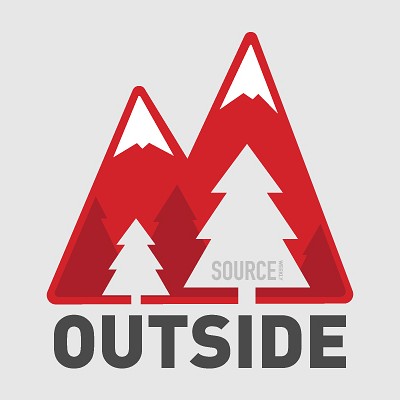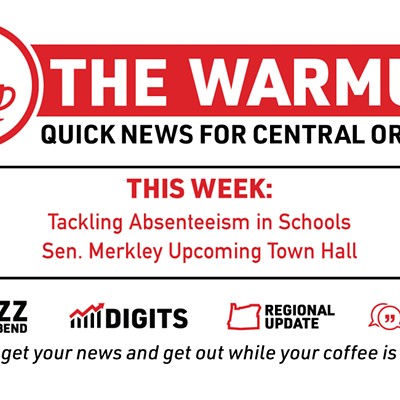Chances are if you've lived in Central Oregon for any length of time, or one of the other ten western states that are sage grouse habitat, you've probably heard about the bird and its plight. Sage grouse inhabit sagebrush steppe, which used to be plentiful in our neck of the woods. Before European settlement, sagebrush covered more than 500,000 square miles; today, oil and gas development, renewable energy projects, subdivisions, wildfire, invasive species, and poorly managed grazing have whittled it down to about 250,000 square miles scattered across 11 states. Perhaps 400,000 grouse survive, down from as many as 16 million.
Many species, when shouldered off their preferred habitats, can make a living elsewhere—robins, coyotes, mule deer. But sage grouse are exceedingly sensitive and can be disturbed by human activity near breeding areas; alarmed by trees and tall structures where raptors can perch. They're loyal to the places they know, even if those places are no longer suitable. Matt Holloran, chief scientist at Wildlife Management Research Support, describes how one female grouse in western Wyoming laid eggs in the same general spot each year as a major natural gas field rose up around her. When a well pad replaced her nest site, she finally moved—but just 30 feet away.
This sensitivity makes greater sage grouse a strong indicator of ecosystem health: If they're not thriving across the vast Interior West, then things look bad for the region's 350 other species, from sagebrush obligates like the sage thrasher and pygmy rabbit, to seasonal migrants like sandhill cranes and elk, according to Jennifer Hayward, Pinedale district conservationist for the Natural Resources Conservation Service (NRCS)—the umbrella agency for the Sage Grouse Initiative (SGI).
The sage grouse's huge range and lack of adaptability complicate things, and the myriad threats it faces—many related to industries that define Western rural economies and identity—make wielding the law a much trickier prospect. Conservative politicians have for years sought to gut the ESA, and many conservationists worry a sage grouse listing would provoke fiercer attack—a prospect underscored by recent congressional attempts to boot several creatures off the list altogether and block funding for others.
But in 2010, the U.S. Fish and Wildlife Service made a decision that set in motion what many are calling a landmark transformation in how the nation recovers imperiled wildlife. Ordinarily, the sage grouse's situation might land it on the federal endangered species list, ushering in much-feared land-use restrictions. But the agency declined to list the bird, not because it didn't need protection—listing was warranted, it declared—but because other creatures needed it more. Instead, the agency promised to make a final call on sage grouse by September 30 of this year.
That court-ordered deadline has been a galvanizing force for grouse conservation like no other. The federal government and the states have partnered with industry, landowners, and environmental nonprofits to protect habitat, spending hundreds of millions of dollars on everything from setting aside vast swaths of sagebrush to cutting down junipers and poisoning ravens. The Bureau of Land Management and Forest Service are cooperating with each other and with the states to protect habitat across tens of millions of acres. If they succeed in doing a good enough job, they may prove that the Endangered Species Act works best when it never goes into effect at all.
"I see a lot of people working hard together. Relationships have formed among people who never used to talk," says John Freemuth, professor of public policy at Boise State University. Still, it remains to be seen whether those relationships will survive once crisis mode has passed, or whether the feel-good collaboration will be enough to save the long-suffering grouse. "This is a pivotal Western moment," Freemuth says. "In 30 years, how will we be writing about this? How did the trajectory change?"
More than one-third of sage grouse range is on private land, where the Endangered Species Act holds little sway. The law prohibits harming protected species, for example, but it can't force landowners to undertake conservation projects that might help those species recover. Meanwhile, the Fish and Wildlife Service is plagued with tight budgets and has a long line of species waiting for recovery. There are more than 1,200 on the list, and 250 candidates await final determinations, some for more than a decade. States, on the other hand, can move faster, and have greater on-the-ground expertise than the federal agency.
That's where the Sage Grouse Initiative comes in. Tim Griffiths, the program's national coordinator from 2010 until July 2015, knows from experience how endangered species struggles can breed mistrust. He was a Fish and Wildlife biologist in Klamath Falls in 2001 and 2002, when farmers' irrigation water was turned off to protect salmon—prompting a near-insurrection—and then turned on while salmon fry died by the thousands. "Wildlife was pitted against agriculture," he recalls, "and in the end, nobody won."
He remained convinced that the two could be reconciled, and in Montana in 2004, he got the chance to prove it with a fish called the fluvial Arctic grayling, which was headed for an emergency listing. Griffiths and State Conservationist Dave White, now both working for the NRCS, helped channel Farm Bill dollars into efforts to keep more water in a stretch of the Big Hole River and improve its quality by helping ranchers move feedlots and restore riparian areas. It was the first time that the NRCS had set aside a dedicated pool of money from its own wildlife habitat incentive programs to help with a broader species conservation initiative. Those voluntary efforts worked so well that the agency decided to apply the approach to a species with a much bigger range: The greater sage grouse.
Now funded with Farm Bill money through 2018, the Sage Grouse Initiative works with more than 75 partners, including state wildlife departments, energy companies, and nonprofit groups. So far, the initiative and its partners have invested about $425 million in projects involving 1,200 landowners, with greater reach than an endangered species listing could achieve. The stats seem impressive: 400,000 acres of important grouse range have been cleared of encroaching conifers, which provide perches for predators and crowd out sagebrush. Ranchers now maintain taller grass on 2.6 million acres—which the initiative says bumps up nesting success by 10 percent. At least 500 miles of fencing have been moved or marked, reducing often-fatal collisions with wires by more than 80 percent. And more than 450,000 acres have been placed in conservation easements, permanently protecting most of them from subdivisions and wind farms, and substantially reducing the threat of oil and gas development.
Many conservation groups, especially the large mainstream ones, regard the federal plans as a huge improvement. "It's achieved a lot of what we hoped it would achieve," says Nada Culver, director of The Wilderness Society's BLM Action Center. "Compared to other planning efforts we've seen, these plans provide more certainty, more landscape-scale cooperation, and more actual protection."
Yet despite all the plans, projects, and collaborations, it's hard to tell if the conservation actions undertaken by states, the Sage Grouse Initiative, or any other group will bump up grouse numbers over the long haul. The birds are fairly long-lived and reproduce slowly, and their populations tend to cycle, hitting natural highs and lows over many years.
A recent study for the Pew Charitable Trusts, for example, found that bird numbers dropped a whopping 56 percent between 2007 and 2013. In August, though, the Western Association of Fish and Wildlife Agencies reported that they've climbed by two-thirds since that time. It may take decades to average out such spikes and dips; many biologists think the overall trend is either stable or downward. "Sage grouse declines are not as dramatic as they were 70 years ago," says Holloran, who's studied grouse since the '90s. "But overall there still seems to be a decline."
Clait Braun, the biologist who helped raise early alarms about grouse, is similarly skeptical. "I have no confidence that anything anyone is doing is working," he says. Wildlife species need connectivity to maintain healthy genetics, and scattered areas of high-priority habitat are not enough to provide that. Nor do any plans set aside large permanent reserves, protected from all development. Voluntary conservation efforts fall short, since many, especially those undertaken by industry, aren't measured to see what they're actually accomplishing. Braun sees the Sage Grouse Initiative as less an effective way to conserve grouse than a taxpayer-funded subsidy program for ranchers. "It's a slick PR effort, but I fail to see the results. There's no data to show that grouse numbers have increased or that their distribution has increased." Within 30 years, he predicts, the birds will persist only in tiny, widely dispersed populations.
However, here in Oregon, Sagebrush Ecosystem Specialist for the NRCS, Jeremy Maestas, remains optimistic. While acknowledging that it's going to take time to determine how sage grouse populations respond to conservation efforts, Maestas points to a songbird study that was published just last week as an early indicator of environmental success and the effectiveness of restoration work. The two-year study demonstrates huge increases in songbirds of high conservation concern, which are equally important in sagebrush steppe. Following restoration activities, such as the removal of invading conifers, the abundance of Brewer's sparrow and green-tailed towhee increased 55 and 81 percent respectively. Maestas says, "that study to me is our first solid evidence here in Oregon that the work we're doing is on the right track."
But what if the sage grouse is listed at the end of the month? What does that mean for conservation? Tom Christiansen, Wyoming's lead sage grouse scientist, puts it more bluntly: "What message would it send to our society," he asks, "if the largest conservation effort ever undertaken failed?"
Even if the grouse is listed, it doesn't mean that "the largest conservation effort ever undertaken" has failed, because the effort itself is likely to define the terms of the listing—possibly even making it stronger than what the agency would have developed on its own. The Fish and Wildlife Service would lean heavily on the existing work when it puts together its own recovery plans. And the private land agreements designed to help grouse would remain in place. The sage grouse, in other words, has already flown.
Additionally, due to a budget rider passed by Congress last December, things are unlikely to change anywhere anytime soon. While the agency will be able to announce whether the sage grouse is or is not still a candidate for listing at the end of the month, if the bird warrants protection, the agency is blocked from developing a rule to protect it as threatened or endangered for at least another year.
Taking a step back and looking at the bigger picture, the SGI can be seen as a new paradigm in conservation and resource management. Rather than the animosity, mistrust, and suspicion that have plagued ESA listings in the past, such as the spotted owl, perhaps SGI demonstrates there are better ways to facilitate species conservation. Maestas notes that one of the most positive things to come out of SGI is the unbelievable response from all the partners to proactively solve problems. This initiative has galvanized support from federal to the local levels, and forged relationships between government agencies and local landowners.
Maestas also states, "We're in it for the long haul, it's a new way of life in terms of collaboration, rather than conflict." Since we're talking about large landscapes, it's going to take a sustained effort over the long term. Fortunately, he feels that we've got the buy-in to be successful, which comes from demonstrating that this isn't just about the one species. "It's not just about grouse, it's about sustainable rangeland."
All of these are important lessons regarding conservation, which could be transferable to other species as well. Maestas articulates that there have been lots of systemic changes in the way land is managed, and "that change gives me enough confidence that we've turned the Titanic and the listing decision is not the end of the story, it's just the beginning of our long- term commitment towards the health of the ecosystem."
Hollaran echoes this sentiment. "This is the start of something bigger," says Holloran. "It has the potential to evolve into the process under which all wildlife is managed," at least for landscape-scale species that range on private land.
Indeed, that's already happening at the NRCS. "There's a big shift in the wind here that's really good," says Jason Weller, head of the NRCS. Within the past year, the Oregon chub was delisted, saved by voluntary landowner conservation that the NRCS helped foster. As with sage grouse, protecting these species protects other creatures that share the same habitat—an approach that the agency has continued to concentrate on.
The Fish and Wildlife Service itself realizes that this kind of effort, with engagement from landowners, industry, and every level of government, can result in the kind of landscape-scale conservation needed to preserve not just a single species, but entire ecosystems. "The success is in the partnerships," Pat Deibert, the Fish and Wildlife Service's national sage grouse coordinator, says. "I'm hopeful that eventually, even if folks don't agree a particular species is of value, they'll realize it's a good business decision for them to do conservation."
No matter what happens with the listing decision at the end of the month, when talking about these newer approaches to conservation Maestas sums it up nicely by saying, "Our generation is going to be making a serious impact for all those future generations coming after us, and that's what gets me excited."
A version of this story originally appeared in the Aug. 17, 2015 issue of High Country News (hcn.org).
























